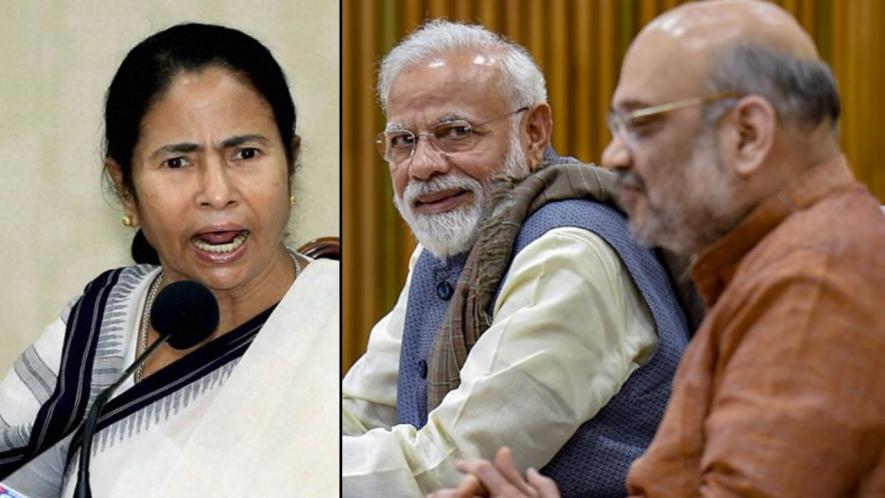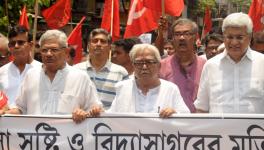Vidyasagar’s Bust Destruction is a Pointer to What’s Coming

The destruction of Ishwarchandra Vidyasagar's bust in a Kolkata college named after the 19th century Bengali scholar-humanist, allegedly by the BJP's saffron-shirted storm-troopers, besides being a direct attack on the 'Bangali' identity and therefore a form of collective memory, also represents a stark shift in the way politics--violent politics--has begun to be practiced and propagated in the state. Bengalis in Kolkata and across other parts of India were quick to equate this wanton act of vandalism with the manner in which BJP hordes pulled down Lenin’s statue in Agartala last year when the party electorally ousted the Marxists from Tripura.
The violent pulling down of Vidyasagar's statue, before it was broken into several parts, again, allegedly by "gutka-chewing non-Bengalis" and "hired hoodlums from Hindi-speaking states" adjoining Bengal was engineered at a time when the Bharatiya Janata Party (BJP) is pulling out all stops to maximise not only its vote share but also parliamentary seats in the state. The Trinamool Congress of Mamata Banerjee has sought to check the BJP's aggressive moves with its own brand of gratuitous violence, fearing loss of electoral ground. The confrontation between the two competing parties was building up over the last five years, if not more: from panchayat to municipal and assembly elections.
With Kolkata's seven Lok Sabha seats preparing to go to the polls on May 19, the shocking vandalism at Vidyasagar College will potentially polarise the city's electorate. There is no doubt whatsoever that over the past 10 years or so, the BJP has been successfully chipping away at the Bengali bhadralok class, especially in the face of the TMC's malgovernance, corruption and minority appeasement, even as it encouraged social lumpenisation and provided patronage to 'syndicated' anti-socials and criminals.
Over the same period, the BJP, besides its vituperative anti-minority programme, also built its own cadre comprising locals and 'hired outsiders'. Many time servers from other parties, sensing 'career advancement' because of the saffron surge, joined the BJP in thousands. After its crushing electoral defeat to the TMC in 2011, the Left continued to view Mamata Banerjee as a greater threat. The Congress, which was one of the early torch-bearers of violent politics in Kolkata and Bengal before the Marxists took over, and now with its base considerably shrunk and limited to a couple of districts--Murshidabad and Malda— stood by and watched as West Bengal fell into a dark abyss.
It is in the context of this socio-political debasement that the vandalism of May 14 evening must be seen. Each of the political parties is responsible for this denouement which marks a nadir insofar as the erosion of Bengal's putative belief in "superior culture" is concerned. But let us also be sure that Bengal is not new to the politics of vandalism. Walls of public buildings would be defaced with political graffiti -- one act of political-ideological vandalism over another, if you will, capricious application of white-and-blue paint on all standing government property and willful pulling down of heritage structures.
The destruction of Vidyasagar's statue is a new form -- the chilling visual images of the statue's broken limbs, torso and head are graphic representations of a "clash of cultures". Bengalis are, understandably, profoundly shocked but they must realise that they themselves are complicit in paving the way for a culture (or is it the lack of it?) embodied and propagated quite shamelessly by the country's chief executive and his lackeys.
But why are statues of historical figures important, especially in the public consciousness? In the first century AD, the Roman culture was to put up elegant busts and statues in public spaces to remind conquered peoples that the victors' social history pervaded those spaces -- for the present and the future. The statues, besides reflecting the conqueror's arrogance also exhibited cultural competition which could be interpreted as an assertion of cultural and aesthetic superiority exhibited through "passive visual images". Historically, statues--anywhere and everywhere--encapsulate issues concerning "control, power and class".
So it is in India in general and Kolkata in particular that statues of statesmen, saints, social reformers and freedom fighters served to construct identities, which is a "continuous dialectical process" between present and past memories. In other words, the physical presence of passive images places a part of the past at the "service of the present needs" which in the case of Bengal and Vidyasagar and the razing of his statue, which is imbued with meaning, serve to form and unleash collective identity.
Framing the past (Vidyasagar's immense achievements) provides the present (the statue's destruction and therefore its absence) with a sense of meaning: uncultured hordes bent on destroying Bengal's superior culture and education. The vandalism at Vidyasagar College inspired and triggered particular memory and identity. After all, cultural memory is engraved in Vidyasagar's statue, no matter that the state of education in Bengal has unquestionably hit rock bottom and may even be close to collapse. In this case, however, the statue of Vidyasagar, while being a hero of the Bengal Renaissance and may carry illusive meaning, is not quite a copy of present-day reality.
Since it ascended to power in West Bengal, the TMC has sought to capture the college unions to deepen and expand its base among the youth; it has done scarcely anything at all to improve the standard and quality of education either at the school, college or university levels. Over the years, as education took a backseat, more and more youth from Bengal migrated to other states, which is a measure of the pathetic state of affairs. This is not to say that under the Left regime, Bengal was a beacon for education. But things have rapidly degenerated since then.
Within hours of the vandalism at Vidyasagar College, the Trinamool Congress found electoral capital in the smashing of the scholar-humanist's statue. Mamata Banerjee's display picture on Twitter and Facebook were replaced by sepia-tinted photos of Vidyasagar. All this, of course, is designed to create and widen Bengali collective memory at a time when vote maximisation is acutely felt in a politically and violently charged atmosphere. The destruction of the statue has certainly outraged Bengali sentiments and it does tantamount to--symbolically--an act of wiping away an icon of the Bengal Renaissance. Will this anger find expression when Kolkata goes to vote on May 19?
The writer is an independent journalist. The views are personal.
Get the latest reports & analysis with people's perspective on Protests, movements & deep analytical videos, discussions of the current affairs in your Telegram app. Subscribe to NewsClick's Telegram channel & get Real-Time updates on stories, as they get published on our website.


















